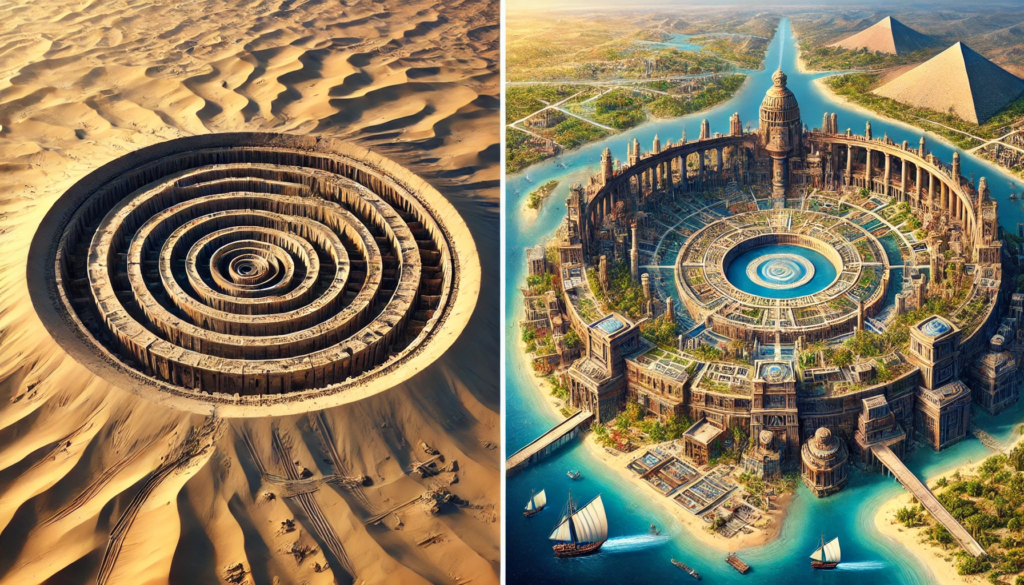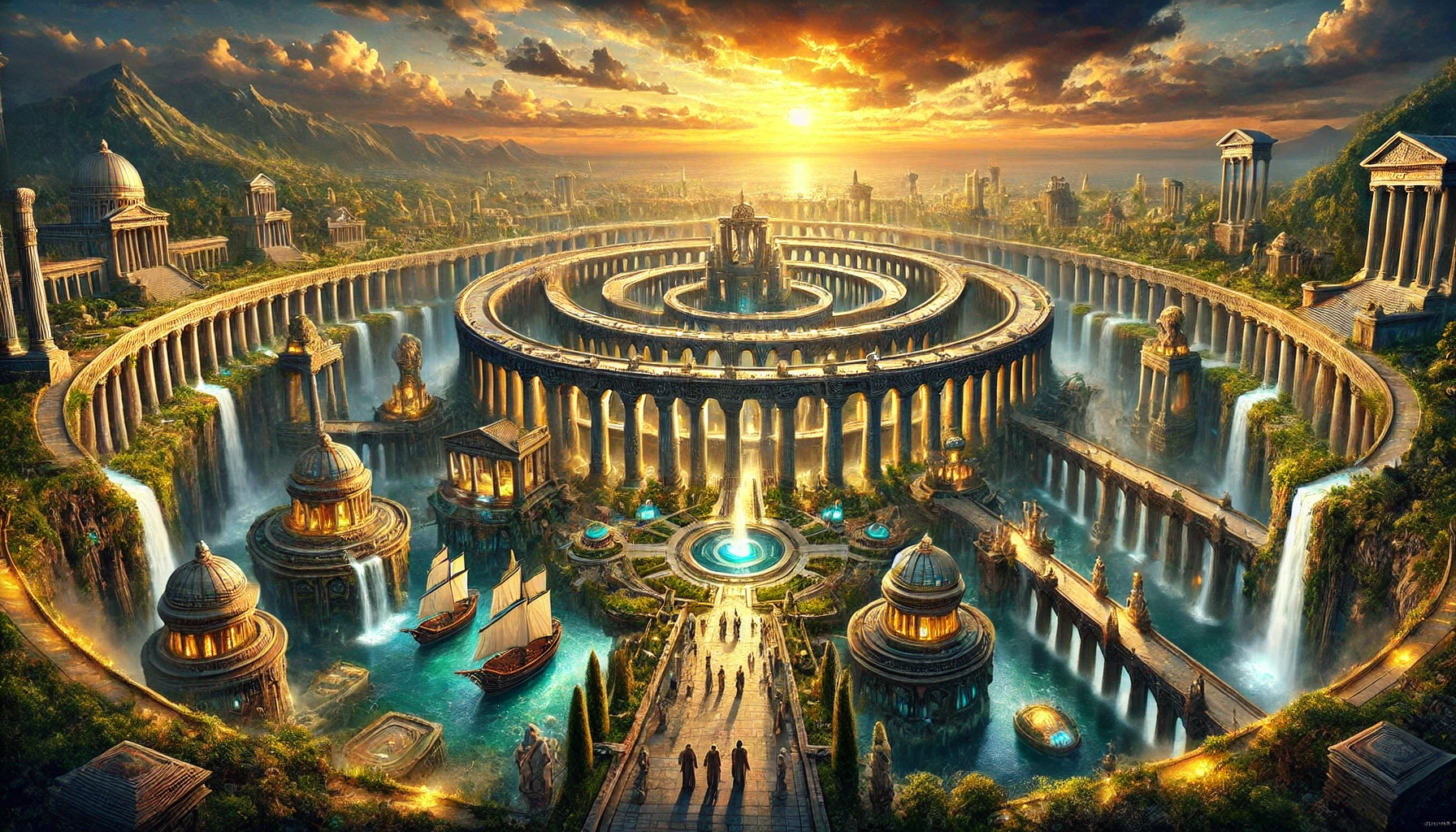A Natural Geological Marvel or the Lost Capital of Atlantis?
The Richat Structure – Deep in the heart of the Mauritanian Sahara lies a massive, enigmatic geological formation known as the Richat Structure, also called the Eye of the Sahara. Spanning nearly 50 kilometers (30 miles) in diameter, this perfectly circular landform has intrigued geologists, historians, and alternative researchers alike.
Some claim that the Richat Structure might be the remains of Atlantis, the fabled lost city described by the ancient Greek philosopher Plato. Could this be the legendary metropolis swallowed by the sea, or is it merely a fascinating geological anomaly? In this investigative piece, we explore the structure’s origins, analyze its possible ties to Atlantis, and examine the evidence supporting both sides of the debate.
What is the Richat Structure?
The Richat Structure is an immense, circular geological feature located in the Sahara Desert of Mauritania, West Africa. Its defining characteristics include:
- Location: Central Mauritania, near the town of Ouadane.
- Size: Approximately 50 kilometers (30 miles) in diameter.
- Appearance: A series of concentric rings, visible from space, resembling an enormous bullseye.
- Geological Composition: Composed of eroded sedimentary and igneous rock formations, estimated to be over 100 million years old.
Originally mistaken for an impact crater, modern geological research suggests the structure formed due to erosion, volcanic activity, and uplifted rock layers. However, its perfectly circular formation and ringed features have led some to speculate that the Richat Structure may hold secrets beyond mere geology.
Theories Connecting the Richat Structure to Atlantis
1. Plato’s Description of Atlantis
The primary source for the legend of Atlantis comes from Plato’s dialogues, Timaeus and Critias, written around 360 BCE. Plato describes Atlantis as:
- A circular city composed of alternating rings of land and water.
- Located “beyond the Pillars of Hercules” (often identified as the Strait of Gibraltar).
- A wealthy and technologically advanced civilization that was eventually destroyed by cataclysmic flooding.
- A land “greater than Libya and Asia combined”, existing 9,000 years before his time.
2. Striking Similarities Between the Richat Structure and Plato’s Atlantis
Many proponents of the Atlantis-Richat hypothesis argue that the Richat Structure bears striking similarities to Plato’s description:
| Plato’s Description | Richat Structure |
|---|---|
| Concentric rings of land and water | Concentric circular landforms |
| Large central island | Raised central landmass |
| Located beyond the Pillars of Hercules | Located south of the Mediterranean, past Gibraltar |
| Destroyed by a cataclysm | Evidence of past flooding in the Sahara |

Jim Allen, a British researcher and proponent of the Richat-Atlantis connection, suggests that the Sahara was once lush and fertile, fitting Plato’s depiction of Atlantis before desertification took hold. Geological studies confirm that the Sahara was a fertile grassland as recently as 5,000–10,000 years ago, suggesting a once-thriving civilization could have existed in this region.
Evidence For and Against the Richat-Atlantis Connection
Evidence Supporting the Atlantis Theory
- Ancient Shorelines and Water Erosion
- Satellite imagery reveals evidence of ancient river systems around the Richat Structure.
- Geological studies suggest the region was once covered in water, with lakes and rivers flowing through it.
- Could these be remnants of the “rings of water” Plato described?
- Human Settlements and Artifacts
- Archaeologists have uncovered stone tools, pottery, and burial sites in the area, indicating ancient human habitation.
- The Richat Structure is surrounded by prehistoric ruins, but no definitive evidence of an advanced civilization like Atlantis has been found.
- Ancient Maps and Descriptions
- Some claim that old world maps—such as those of Herodotus (circa 450 BCE)—depict West Africa as an important civilization.
- The Piri Reis Map, a 16th-century map drawn from ancient sources, suggests advanced geographical knowledge of Africa’s interior before it was officially mapped.
Counterarguments and Scientific Consensus
- Geological Formation, Not Man-Made
- Most geologists agree that the Richat Structure is a natural formation, likely caused by erosion and volcanic uplift.
- No archaeological remains of large-scale buildings or infrastructure consistent with Plato’s Atlantis have been found.
- Atlantis as Allegory
- Many historians argue that Atlantis was not a real place, but rather an allegory Plato used to critique the moral and political corruption of his time.
- There is no direct mention of Atlantis in any texts predating Plato, suggesting it may be a purely philosophical construct.
- Timeline Discrepancies
- Plato places Atlantis 9,000 years before his time, roughly 11,600 years ago.
- Archaeological evidence suggests that no advanced civilization existed in the Sahara at this time, though early humans may have occupied the area.
What Do Experts Say?
Dr. Paul Bahn, an archaeologist and historian, states:
“While the idea of Atlantis is enticing, we must be careful not to project modern myths onto historical landscapes. The Richat Structure is fascinating, but there is no conclusive evidence linking it to an advanced civilization.”
Randall Carlson, a geological researcher, argues:
“The Sahara’s history is still full of mysteries. Ancient climate shifts could mean that entire civilizations were wiped out and erased from history.”
Final Verdict: A Compelling Mystery, But No Definitive Proof
The Richat Structure is undoubtedly one of the most fascinating natural formations on Earth. While its circular landforms and ancient history invite speculation, there is currently no definitive evidence linking it to Atlantis. However, as new archaeological techniques emerge, and further studies are conducted, who knows what future discoveries might reveal?
Further Reading and Resources
If you’re interested in learning more about the Richat Structure, Atlantis, and ancient civilizations, check out the following resources:
- Books:
- Documentaries:
- Research Papers & Articles:
- NASA’s geological survey of the Richat Structure (NASA)
- Plato’s original dialogues on Atlantis (MIT Classics)
The Mystery of Atlantis and the Richat Structure
The mystery of Atlantis continues to inspire debate, and the Richat Structure remains a geological wonder with historical intrigue. Whether it was once a thriving civilization or simply a mesmerizing natural feature, one thing is certain—it captures the imagination like few places on Earth.
Could future excavations uncover new evidence supporting the Richat-Atlantis connection? Or is Atlantis destined to remain a myth, forever lost to history?
Only time will tell.





